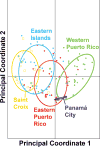ORIGINS AND GENETIC DIVERSITY OF INTRODUCED POPULATIONS OF THE PUERTO RICAN RED-EYED COQUÍ, ELEUTHERODACTYLUS ANTILLENSIS, IN SAINT CROIX (U.S. VIRGIN ISLANDS) AND PANAMÁ
- PMID: 28649148
- PMCID: PMC5481165
- DOI: 10.1643/CG-16-501
ORIGINS AND GENETIC DIVERSITY OF INTRODUCED POPULATIONS OF THE PUERTO RICAN RED-EYED COQUÍ, ELEUTHERODACTYLUS ANTILLENSIS, IN SAINT CROIX (U.S. VIRGIN ISLANDS) AND PANAMÁ
Abstract
The Red-eyed Coquí, Eleutherodactylus antillensis, is a terrestrial frog endemic to the Puerto Rican Bank (Puerto Rico and numerous islands and cays off its eastern coast), in the eastern Caribbean Sea. The species was likely introduced in Saint Croix, an island c. 100 km southeast of Puerto Rico, in the late 1930s, and in Panamá City, Panamá, in the late 1950s or early 1960s, but the source(s) of these introductions are unknown. We analyzed sequence data from one mtDNA locus and four nuDNA introns to infer the origin(s) of the Saint Croix and Panamá City populations and quantify their genetic diversity. Saint Croix and Panamanian populations do not share any haplotypes, and they cluster with different native populations, suggesting that they are derived from separate sources in the Puerto Rican Bank. Patterns of population structure trace the probable sources of E. antillensis in Saint Croix to islands off Puerto Rico's eastern coast, which include Vieques, Culebra, Saint Thomas, Saint John, Tortola, and Virgin Gorda, and possibly to eastern Puerto Rico as well. In contrast, Panamá City E. antillensis probably originated from either western or eastern Puerto Rico. Genetic diversity in the introduced populations is similar to or lower than in populations in the species' native range, indicating that genetic diversity has not increased in the alien frogs. Our findings may facilitate the development of preventive measures to minimize introductions of non-native amphibians in the Caribbean and Central America.
Keywords: Caribbean Sea; Puerto Rican Bank; West Indies; human-mediated introduction; introduced species; population genetics.
Figures



Similar articles
-
Sea level, topography and island diversity: phylogeography of the Puerto Rican Red-eyed Coquí, Eleutherodactylus antillensis.Mol Ecol. 2012 Dec;21(24):6033-52. doi: 10.1111/mec.12020. Epub 2012 Nov 19. Mol Ecol. 2012. PMID: 23163292
-
Climate as a driver of tropical insular diversity: comparative phylogeography of two ecologically distinctive frogs in Puerto Rico.Ecography. 2015 Aug 1;38(8):769-781. doi: 10.1111/ecog.01327. Epub 2015 Feb 25. Ecography. 2015. PMID: 26508809 Free PMC article.
-
Strong founder effects and low genetic diversity in introduced populations of Coqui frogs.Mol Ecol. 2009 Sep;18(17):3603-15. doi: 10.1111/j.1365-294X.2009.04308.x. Epub 2009 Aug 10. Mol Ecol. 2009. PMID: 19674300
-
The big potential of the small frog Eleutherodactylus coqui.Elife. 2022 Jan 14;11:e73401. doi: 10.7554/eLife.73401. Elife. 2022. PMID: 35029143 Free PMC article. Review.
-
Historical versus contemporary medicinal plant uses in the US Virgin Islands.J Ethnopharmacol. 2016 Nov 4;192:74-89. doi: 10.1016/j.jep.2016.07.005. Epub 2016 Jul 1. J Ethnopharmacol. 2016. PMID: 27377341 Review.
Cited by
-
A review of the introduced herpetofauna of Mexico and Central America, with comments on the effects of invasive species and biosecurity methodology.Zookeys. 2021 Mar 8;1022:79-154. doi: 10.3897/zookeys.1022.51422. eCollection 2021. Zookeys. 2021. PMID: 33762869 Free PMC article.
References
-
- Bai C, Ke Z, Consuegra S, Liu X, Li Y. The role of founder effects on the genetic structure of the invasive bullfrog (Lithobates catesbeianaus) in China. Biological Invasions. 2012;14:1785–1796.
-
- Balinsky JB. Adaptation of nitrogen metabolism to hyperosmotic environment in Amphibia. Journal of Experimental Zoology. 1981;215:335–350.
-
- Barbour T. A contribution to the zoogeography of the West Indies, with especial reference to amphibians and reptiles. Memoirs of the Museum of Comparative Zoology at Harvard College. 1914;44:205–359.
-
- Barker BS, Rodríguez-Robles JA, Aran VS, Montoya A, Waide RB, Cook JA. Sea level, topography, and island diversity: phylogeography of the Puerto Rican Red-eyed Coquí, Eleutherodactylus antillensis. Molecular Ecology. 2012;21:6033–6052. - PubMed
Grants and funding
LinkOut - more resources
Full Text Sources
Other Literature Sources
